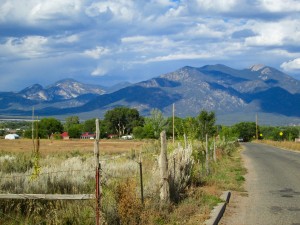We were strangers, thrown together by accident – or should I say Destiny? – like pilgrims on our way from London to Canterbury. But in this case, we were going from Albuquerque to Taos in a shuttle van. Seven of us, not counting our busy driver, each with tales to tell.
I’ve made this three-hour van trip many times before from New Mexico’s international airport back home to Taos, but never before has it been so fascinating and so much fun. It was like an impromptu party — sans drinking or dancing – on wheels.
This ride had a timeless quality about it, akin to Chaucer’s late-14th century Canterbury Tales, in which the group traveling together entertained one another with stories. Instead of looking to their iPhones for connection, as so many present-day travelers do, my fellow travelers paid attention to each other, with respect, appreciation, and good humor.
There was Keith in the front seat, who’d spent the night at the airport because his flight in had been so delayed and there were no available hotel rooms in Albuquerque due to the weekend Balloon Fiesta. Despite no sleep, Keith, who calls both Portland, Oregon, and Angel Fire, New Mexico, home, regaled our group with stories and intermittent love songs.
Then there was Carlos, who used to call Taos home but now lives in D.C., where he works as a lawyer for the Justice Department. He was returning to Taos for a brief visit to celebrate a special little girl’s birthday. His story was filled with love, plus photos of the soon-to-be birthday girl.
Nancy, whose home, she said, has always been Texas, was coming to Taos – not for the first time – to give a talk on indigenous spirituality at SMU. When she spoke of her work with the Waitaha Grandmother Council, everyone listened, riveted.
Like Nancy, Sam, a professor at the University of Kansas, was coming to give a lecture. His area of expertise, though, is Native American architecture. Sam did his graduate work in New Mexico, but he calls Kansas home.
Corrina, a sculptor who’s claimed Atlanta, Georgia, as her home, was on her way to Taos to stay with and comfort her mother on the one-year anniversary of her brother’s sudden death. It would be a short visit, but it would be sweet for both mother and daughter to be together.
Ruth, a small and frail retiree well into her eighties, was returning alone from three weeks in West Virginia, where she visited relatives. She’s called New Mexico home all her life and is still enthralled by the scenery we passed, doing over 60 mph in the van.

And I was coming home to Taos after four months in the central mountains of Mexico, where I’d also felt at home. Which made me wonder: What is “home”? Can “home” be defined or explained? How many places in the world have I called home?
The place I once should have called home, in my hometown in suburban New Jersey, was more like a war zone than a home. Yet other places, especially those far afield, like the homes I made in Gabon and Mali, Africa, felt like true homes to me. How can I adequately explain this?
“Home is where the heart is,” Pliny the Elder is credited with saying. “Where thou art, that is Home,” Emily Dickinson wrote. Yes, I agree with both Pliny and Emily. Yet I think Maya Angelou comes closest to my sentiments with: “I long, as does every human being, to be at home wherever I find myself.”
I felt at home with my fellow travelers on the shuttle van. Which makes me think that “home” is not so much a place as it is a human and humane connection.
